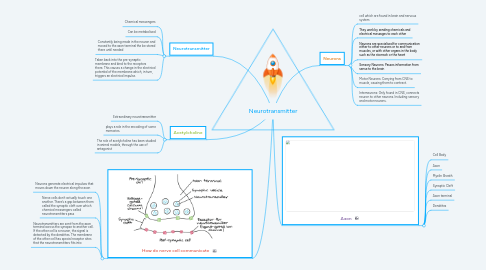Neurotransmitter
by Chu Ryan

1. Axon
1.1. Cell Body
1.2. Axon
1.3. Myelin Sheath
1.4. Synaptic Cleft
1.5. Axon terminal
1.6. Dendrites
2. Neurons
2.1. cell which are found in brain and nervous system
2.2. They work by sending chemicals and electrical messages to each other
2.3. Neurons are specialised for communication either to other neurons or to and from muscles, or with other organs in the body such as the stomach or the heart
2.4. Sensory Neurons: Passes information from sense to the brain
2.5. Motor Neurons: Carrying from CNS to muscle, causing them to contract.
2.6. Interneurons: Only found in CNS, connects neuron to other neurons. Including sensory and motor neurons.
3. Neurotransmitter
3.1. Chemical messengers
3.2. Can be metabolised
3.3. Constantly being made in the neuron and moved to the axon terminal the be stored there until needed
3.4. Taken back into the pre-synaptic membrane and bind to the receptors there. This causes a change in the electrical potential of the membrane which, in turn, triggers an electrical impulse.
4. Acetylcholine
4.1. Extraordinary neurotransmitter
4.2. plays a role in the encoding of some memories.
4.3. The role of acetylcholine has been studied in animal models, through the use of antagonist
5. How do nerve cell communicate
5.1. Neurons generate electrical impulses that moves down the neuron along the axon
5.2. Nerve cells don’t actually touch one another. There’s a gap between them called the synaptic cleft over which chemical messengers called neurotransmitters pass
5.3. Neurotransmitters are sent from the axon terminal across the synapse to another cell. If the other cell is a neuron, the signal is detected by the dendrites. The membrane of the other cell has special receptor sites that the neurotransmitters fits into


